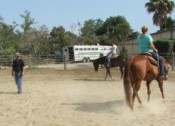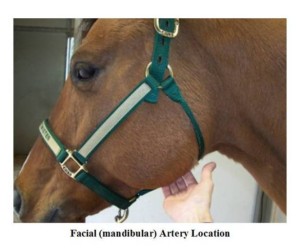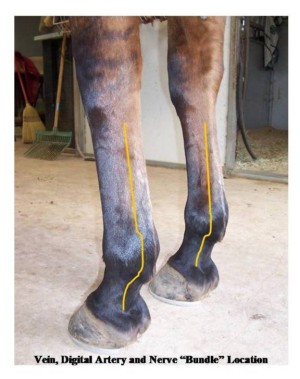





And the Beat Goes On... The Equine Pulse By Eleanor Blazer copyright©2014 Quick - what's the average resting pulse rate of your horse? You may know the normal resting pulse rate of an adult horse is between 25 and 50 beats per minute (bpm), but what is your horse's rate? Because of the wide margin of normalcy, the resting pulse rate for individual horses should be recorded. The pulse is one of the three vitals signs taken to check the condition of the horse's health. The other two are the temperature and respiration rate. An abnormal resting pulse rate can signify infection, dehydration, stress, pain and an erratic heart beat. The pulse must be taken when the horse is calm and resting. Do not try to get an accurate reading when there is a lot of activity in the barn; just before feeding time or after exercise. Don't make a big production of it - stay calm and keep the horse quiet. The pulse should be taken at the same time every day for five days. Make a note of each reading and average them. To get an average, add the results of the five days and divide the answer by five: the answer is the average normal pulse for that horse. The easiest way to check a horse's heart rate is to use a stethoscope and listen to the heart. Place the stethoscope on the girth area just behind the left elbow. The heart makes two sounds, lub then dub, which counts as a single beat. Count the number of beats that occur in 15 seconds. Multiply that by four and you'll have your horse's resting heart rate per minute. *Hint - most watches no longer have second hands, so I use the timer on my phone. You should also know how to manually take the pulse. In order to do this you have to find where an artery is close to the surface. There are several locations, but the easiest to find is under the jaw. Stand on the left side of a haltered horse; hold the lead shank with your left hand and use your right hand to locate the pulse. You are trying to find the facial (mandibular) artery. Use the fingers of your right hand and feel along the inside of the lower jaw. The artery will be in the vicinity of the last cheek tooth - inside the jawbone. When you reach the right location you'll feel a cord-like shape. Press that structure lightly against the jawbone - you should detect the pulse. You need to exert some gentle pressure, just touching the skin will not be enough. Count the number of beats that occur in 15 seconds and multiply by four. There is a second location for taking a horse's pulse, the digital pulse. An easily detected digital pulse can be a sign of inflammation in the hoof. Inflammation is a symptom of laminitis, an internal abscess, a bruise or other trauma to the hoof. (Be aware that a horse could be suffering from one of these illnesses and still have a normal digital pulse rate. Make note of other symptoms, such as heat, lameness, temperature, depression, accelerated heart rate and overall attitude.) There are two digital arteries. Just above the fetlock they branch off from the medial palmar artery and continue down to the hoof - one on each side. The one to the inside of the horse is called the medial palmar artery; the one to the outside is the lateral palmar artery. Above and below the fetlock they are close to the surface and can be monitored for pulse. In a normal horse the digital pulse can be very hard to detect. But, that is a good thing. An abnormally strong digital pulse is described as a "bounding pulse". Dr. Jack Sales, DVM (instructor for the online course Equine Health and Disease Management) explains, "A bounding pulse is not a fast pulse, but a strong, throbbing sensation. The digital pulse still corresponds to the heart rate, but it is stronger because there is an increased amount of blood going to the foot because of the inflammation." It is possible for one or more legs to have a bounding digital pulse and the others to be normal. Both front legs presenting a bounding pulse may indicate laminitis. One leg exhibiting a bounding pulse may signify an abscess. Practice locating the digital pulse. Start with a clean, haltered horse. It will help if the long hair on the fetlock and pastern is clipped. We're using the left front leg for the demonstration. The artery for which you are searching is "bundled" with vein and nerve. This "bundle" lays in the groove between the suspensory ligament (raised cord-like structure in the hollow area on the side of the leg) and flexor tendon (runs down the back of the leg). This area is above the fetlock joint and on both sides of the leg. The two nerve, artery and vein bundles continue over the each back "corner" of the fetlock and down the back sides of the pastern. The bundles are not directly centered under the back of the fetlock, but are on each "back edge". If you get too far forward you may confuse the bundle with the suspensory ligament branch. The ligament is toward the center of the pastern, when looking at the leg from the side. It will feel hard and not have a pulse. When searching for the artery you'll have to apply light pressure. It will be hard to detect by just touching the surface. When you find it you'll feel the cordlike bundle under your fingertips. Using light pressure, concentrate and try to feel the pulse; don't press too hard or you'll stop the blood flow and there will be nothing to feel. The pulse will be very light in a healthy horse. If the horse has a bounding pulse, it will be easy to detect and you'll need to consult a veterinarian. Learn how to detect the digital pulse on all four legs. Just checking one leg won't rule out a problem with one of the other hooves. Also a normal heart rate detected with a stethoscope or checked under the jaw will not rule out a foot problem. |

